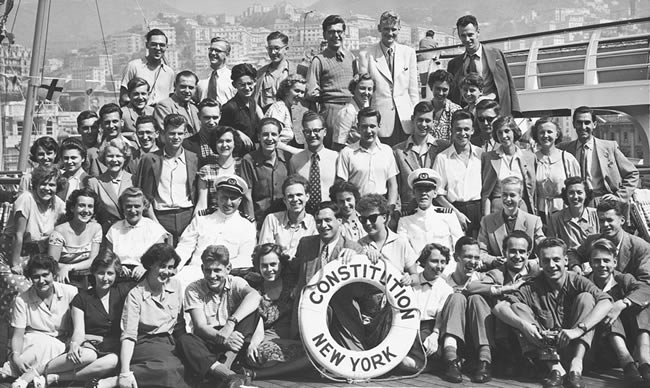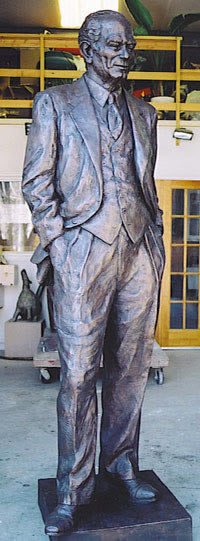The 60th Anniversary of the Fulbright Program in Austria 1950 – 2010
This year marks the 60th anniversary of the establishment of the Fulbright Program in Austria. No other academic or cultural exchange program has contributed so much to promoting mutual understanding between the peoples of Austria and the United States.
Austrian Fulbrighters embark for the United States in the 1950s
Since its inception in 1950, the Fulbright Program has played an instrumental role in the promotion of Austro-American relations by facilitating the bilateral educational exchange of over 5,400 students, teachers, scholars, and professionals from both countries.
Since the early 1960s, the Fulbright Commission in Vienna also has coordinated the placement of an additional 2,800 American university graduates as teaching assistants at secondary schools in communities large and small throughout Austria, and in the past decade it has concluded a wide range of innovative cooperative agreements with Austrian institutions to establish new jointly- funded Fulbright awards.
Statue of Senator Fulbright in Washington, D.C.Senator J. William Fulbright
The establishment of the Fulbright Program in 1946 owes its existence to Senator J. William Fulbright’s vision of peace to be achieved by dialogue with other cultures through international educational exchange. Born in 1905 and raised in Fayetteville, Arkansas, Fulbright was the recipient of a Rhodes Scholarship that allowed him to study at Oxford from 1925-28.
After completing his studies in England he settled for six months in Vienna, where he developed a special and personal attachment to Austria. At the age of twenty-three, Fulbright was exposed to the tensions and political turmoil of Central Europe, and he spent a great deal of time in Vienna with American journalists and European correspondents for English and American newspapers. These contacts provided him with what his biographer Randall Woods has called "his introduction to the real world of international politics."
The experiences gained at Oxford and Vienna had changed his life and expanded his horizons from that of the parochial background of a small town in Arkansas to the world stage. These formative years for Fulbright shaped his later vision of the need for dialogue between cultures. By overcoming the limitations of one’s cultural roots and accepting and understanding other cultures one learned ”to perceive the world as others see it. . . ”
Fulbright returned to the United States in 1929, married, studied law at George Washington University, and worked in and out of government in Washington, D.C., and his home town of Fayetteville. He was appointed president of the University of Arkansas in 1939, then ran successfully for the U.S. House of Representatives in 1942 and for the U.S. Senate in 1944. He immediately understood the implications of the advent of nuclear weapons and their capacity for nuclear destruction which required one to heed the admonition of Albert Einstein that “we must acquire a new manner of thinking about mankind, if mankind is to survive.”
Eight weeks after Hiroshima and Nagasaki, he announced his intention to introduce legislation to establish an educational exchange program to promote good will. Fulbright was convinced that a transformation in the way that nations viewed each other could not be achieved in the rarefied atmosphere of conventional diplomacy and traditional international relations nor as a result of the efforts of the wealthy or elite, but rather by providing young people with an opportunity to experience the diversity of different worldviews through international exchange.
From those participants would emerge leaders who had learned to appreciate other perspectives, and they would eventually shape “policies based on tolerance and national restraint.”
The Austrian-American Educational Commission
The Fulbright Program was based on a simple but ingenious idea that had nothing to do with educational exchange but required the amendment of a piece of legislation known as the Surplus Property Act of 1944.
Austrian Fulbrighters on their way to New York
After World War II, the U.S. government was accumulating substantial monies from the sale of wartime surpluses it had stockpiled overseas – food, fuel, vehicles and other equipment – and in 1946 Fulbright proposed an amendment to this act earmarking part of the income from these sales to finance an educational exchange program that would later bear his name.
Austria was among a handful of countries that quickly established Fulbright programs in the late 1940s and early 1950s. The initial Fulbright Agreement between the Republic of Austria and the United States of America was signed on June 6, 1950, and the first exchanges took place under its auspices during the 1951-52 academic year.
On June 25, 1963, a new Fulbright Agreement was concluded, establishing the Austrian-American Educational Commission (AAEC), better known as the Austrian Fulbright Commission. From the beginning, binational decision making has been the core of this bilateral exchange program. Five Austrians and five Americans are appointed by their respective governments to serve on the AAEC board, which is responsible for overseeing finances, policy making and the selection of Fulbright grantees.
The new Austrian-American Fulbright Agreement concluded in 1963 was unique in two respects. First, in the early 1960s the United States was in the process of turning the substantial funds associated with the European Recovery Program in Austria – better known as the Marshall Plan – over to the Austrian government.
In an exchange of diplomatic notes the U.S. government proposed that the Austrian government dedicate 60 million Schillings of the so-called counterpart funds it was to receive as its contribution toward the Fulbright Program in the future – over 4 million US Dollars at the time – and to earmark 7.5 million Schillings for the establishment of American Studies Programs at Austrian universities.
The Austrian government gladly agreed to do so. Second, in 1963 Austria was the first country in the world to conclude a new, "second generation" binational Fulbright Agreement with the United States that established the Austrian-American Educational Commission funded by the Austrian government with funds from the Marshall Plan and with an annual contribution from the federal budget to carry out its mandate to institutionalize American Studies at Austrian universities.
U.S. Fulbright grantees arrive at Vienna's Westbahnhof train station in 1951.
After these Marshall Plan monies were depleted in the mid-1980s, the Austrian government also started making a direct annual contribution to the Fulbright Program. Today the AAEC funds its program with annual contributions from the Austrian and U.S. governments, along with income for seventeen jointly-sponsored grants provided by partner organizations.
They include ten Austrian universities, the Sigmund Freud Museum (Vienna), the International Research Center for Cultural Studies (Vienna), the Diplomatic Academy (Vienna), the Museum Quartier's quartier21 (Vienna), the Center for Austrian Studies (University of Minnesota), and Kathryn and Craig Hall, the former U.S. Ambassador to Austria and her husband.
Today, Austria is among a select group of countries participating in the Fulbright Program that contribute more to the program than the U.S. government. Between seventy and eighty students, foreign language teaching assistants, and scholars and scientists – half Austrian and half American – receive Fulbright awards each year.
Since 1962, the AAEC also has facilitated the placement of 2,800 U.S. college and university graduates in the Austrian Ministry of Education’s Anglophone Teaching Assistantship Program that provides native speakers of English with opportunities to enhance language instruction in Austrian classrooms.
This program can truly be considered a major contribution toward the promotion of mutual understanding between the U.S. and Austria. In this past year, for example, 140 U.S. Teaching Assistants taught in over 200 different schools in all nine Austrian provinces and had contacts with thousands of students on a daily basis.
The 60th Anniversary of the Austrian-American Fulbright Program
On June 7, 2010, the Fulbright Commission commemorated the 60th anniversary of the founding of the Austrian-American Fulbright Program at the Austrian Academy of Science in Vienna, an event attended by over 350 friends, associates, and alumni of the Fulbright Program. U.S. Ambassador to Austria William C. Eacho III and Austrian Federal Minister of Science Dr. Beatrix Karl, the honorary co-chairs of the Austrian-American Educational Commission, greeted guests with reflections on the importance of the Fulbright Program.
The core event of the commemoration was the screening of a documentary film the AAEC had commissioned from Georg Steinböck, “Fulbright at Sixty: The Austrian-American Fulbright Program, 1950 – 2010.” Steinböck’s documentary is based on interviews with different generations of Austrian Fulbright recipients, starting with members of the inaugural class of 1951-52 and including current American Fulbright grantees, archival material, historical photos and Super 8 footage.
Dr. Lonnie Johnson, Director of the Austrian-American Educational Commission
In her remarks, Minister Karl called the Fulbright Program ". . . a model and the ‘grandfather’ of other academic exchange programs founded later." She noted the importance of the program for the 3,400 Austrian Fulbright students and scholars and emphasized the enduring aspects of the program since its inception: the opportunity to experience foreign cultures and gather experience, the promotion of mutual understanding, new contacts and enduring friendships, the acquisition of new skills and expertise, scientific and scholarly networking, and the capacity for insight and tolerance that living abroad can engender.
She also remarked on the importance of the Fulbright Program for the establishment and development of American Studies in Austria and, in closing, thanked Dr. Lonnie Johnson, the executive director of the AAEC, and his staff for their committed and successful management of the Austrian-American program.
Dr. Beatrix Karl, Austrian Federal Minister for Science and Research
The new Austrian-American Fulbright Agreement concluded in 1963 was unique in two respects. First, in the early 1960s the United States was in the process of turning the substantial funds associated with the European Recovery Program in Austria – better known as the Marshall Plan – over to the Austrian government. In an exchange of diplomatic notes the U.S. government proposed that the Austrian government dedicate 60 million Schillings of the so-called counterpart funds it was to receive as its contribution toward the Fulbright Program in the future – over 4 million US Dollars at the time – and to earmark 7.5 million Schillings for the establishment of American Studies Programs at Austrian universities.
The Austrian government gladly agreed to do so. Second, in 1963 Austria was the first country in the world to conclude a new, "second generation" binational Fulbright Agreement with the United States that established the Austrian-American Educational Commission funded by the Austrian government with funds from the Marshall Plan and with an annual contribution from the federal budget to carry out its mandate to institutionalize American Studies at Austrian universities.
After these Marshall Plan monies were depleted in the mid-1980s, the Austrian government also started making a direct annual contribution to the Fulbright Program. Today the AAEC funds its program with annual contributions from the Austrian and U.S. governments, along with income for seventeen jointly-sponsored grants provided by partner organizations. They include ten Austrian universities, the Sigmund Freud Museum (Vienna), the International Research Center for Cultural Studies (Vienna), the Diplomatic Academy (Vienna), the Museum Quartier's quartier21 (Vienna), the Center for Austrian Studies (University of Minnesota), and Kathryn and Craig Hall, the former U.S. Ambassador to Austria and her husband.
Today, Austria is among a select group of countries participating in the Fulbright Program that contribute more to the program than the U.S. government. Between seventy and eighty students, foreign language teaching assistants, and scholars and scientists – half Austrian and half American – receive Fulbright awards each year.
Since 1962, the AAEC also has facilitated the placement of 2,800 U.S. college and university graduates in the Austrian Ministry of Education’s Anglophone Teaching Assistantship Program that provides native speakers of English with opportunities to enhance language instruction in Austrian classrooms. This program can truly be considered a major contribution toward the promotion of mutual understanding between the U.S. and Austria. In this past year, for example, 140 U.S. Teaching Assistants taught in over 200 different schools in all nine Austrian provinces and had contacts with thousands of students on a daily basis.






